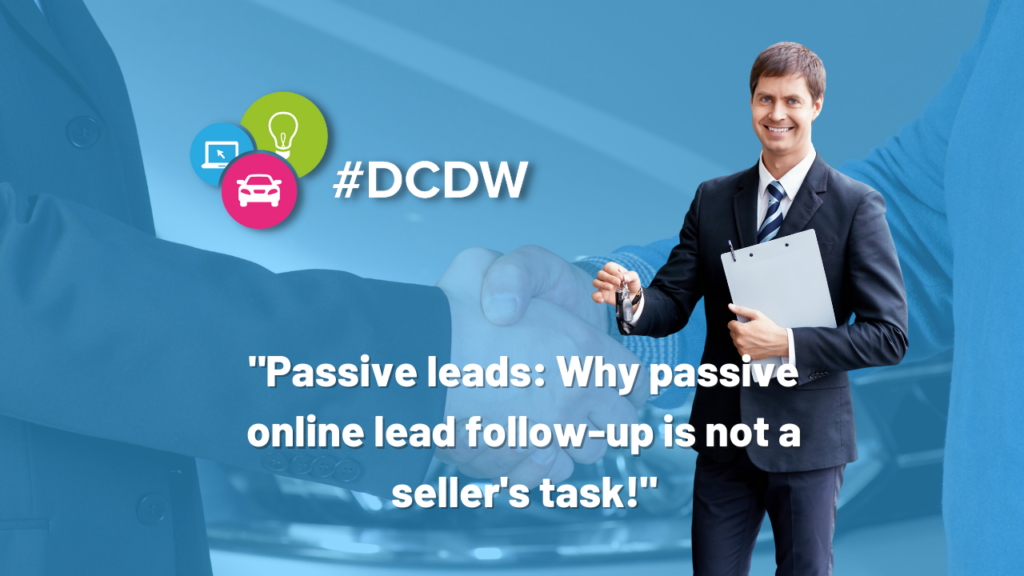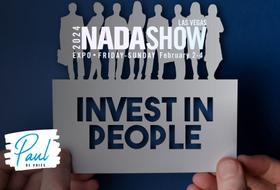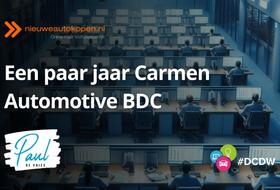
Passive leads: Why passive online lead follow-up is not a seller’s task!
1 december 2021, PaulPassive leads are customers who have not yet entered the purchase process or are in the early stages. This category includes, for example, customers whose lease contract expires in six months, customers who are contacted 12, 24, or 36 months after purchase for satisfaction follow up, and, any customer whose historical data indicates they are in a time frame to consider a vehicle purchase to replace their current vehicle. Because the initiative for the contact does not lie with the customer and the customer does not expect a call, the likelihood for a sales discussion is very slim. These kinds of leads do not belong to a salesperson. Not today, not tomorrow, never!
Passive leads should be delegated to the Call Center, the active lead is for the salesperson!
In most conversations I have with dealers and sales managers, the same question comes up: who should follow up the online leads? My answer is simple: the sales team. Why do I believe that? Online lead follow-up and following up passive leads is a task that you as a company could outsource to a KCC/BDC. I know all about this from my shareholding in Carmen Automotive BDC. Now you are probably thinking: what is the added value of a KCC/BDC for lead follow-up if a salesperson can do better? That completely depends on the type of lead.
It is crucial that your best salespeople follow up on hot, active leads.
Right upfront, we need to distinguish between different types of online leads. Active online leads are potential customers who are asking a question. For example, they may make contact with the dealership via a web form or via the website button such as ‘Call the dealer’. Customers who contact the dealership by telephone via the Internet are considered active online leads. Customers who take the initiative themselves, and who are usually ready to buy are defined as active online leads. For a car company, these customers are worth gold. They are hot leads, and you want to use your best sales representatives for that contact; someone who has been extensively trained in sales techniques and who knows everything about products, services, and trade-in conditions. Someone who, based on his or her experience and customer focus, converts a hot lead into a sale in no time. In short: the best way to convert this customer to a sale is for the salesperson to contact them.
In historical practice: salespeople go for physical leads.
Let’s face it, many salespeople are opportunistic. They go for the easiest kill. Leads, on the surface, do not always seem like the quickest or easiest conversion. Following up on an online lead can be tricky; more difficult than talking to a customer who walks into the showroom. There are several reasons for this opportunism, and there are also ways to change that mindset. I’ll go into that in more detail later. More and more car companies are defining their lead follow-up process as it relates to salespeople. When the salesperson follows up on an online lead and does not get the customer directly on the line, they often must call or email at least four times before they have the right to say: I can’t get the customer. Most sellers make two calls and then give up. Often, they use excuses like: physical customers take precedence, that calling or e-mailing more often starts to look like spam, and that they find calling and e-mailing annoying themselves.
Sellers are opportunists, so am I!
Making hard choices about leads
It makes sense that sellers would prefer physical customers, but that ignores the fact that most physical customers have evolved from online leads. Giving more attention to online leads means that you can take advantage of more sales opportunities. How do you handle that? With training, guidance, and practice, most salespeople can get to the point where they can identify and successfully nurture active online leads. This is especially true once they discover that they can quickly turn an active online lead into an active physical lead. As a car company, you should therefore ask yourself two things for passive lead follow-up. Do I want passive leads handled by my most experienced salespeople, and do I want this process delegated to people who are reluctant to do it?

The added value of a KCC/BDC
Passive lead follow-up is never a job for the salesperson in my view. A KCC/BDC and online sales staff can work these type leads much better. From our own experience and that of our customers, a KCC/BDC (Carmen Automotive BDC) like ours is demonstrably more productive, effective, and economical. Another advantage of a KCC/BDC is that, as a car company, you can be sure that the agreed upon calling process is actually carried out. In the current environment, sometimes a check mark is put in the box even if follow-up contact with the customer was not actually made.
How effective can the salesperson be?
Active online lead follow-up is the only truly controllable part of the sales process. Management can actually see and hear how salespeople deal with sales opportunities. I have listened to more than 1,000 conversations via Calldrip. In the conversations, salespeople and KCC employees follow up active online leads. All calls have one match. The better the salesperson or KCC employee handles customer objections, the greater the conversion rate. Objections such as ‘What can be discounted without a trade-in’ or ‘What is my car worth because I want an appraisal first’. The way salespeople turn customer objections into sales opportunities says a lot about their sales qualities. There is a big difference between good salespeople and good writers. In today’s market, both types of sellers can achieve good results. Only one seller can do that with a headwind, while the other can only do it with a tailwind.
Bad leads or bad salespeople
Calldrip makes sales skills and sales techniques audible and measurable. How a salesperson handles objections over the phone says a lot about how the same salesperson handles objections in a physical environment. The same applies the other way around. If a salesperson makes a physical sales call with the customer, presents the proposal, tries to close the deal, and is not successful right away, what’s the logical next step? That’s right, follow up the quote by phone and e-mail. Where have we heard that before? This process is equivalent to following up an active online lead. The game is the same, only the order is different. Good salespeople manipulate any sales situation. Only bad salespeople blame bad leads.
Pay on numbers or on sales potential?
How do you motivate salespeople to get more out of online leads? Taking the online lead follow-up job completely away from salespeople doesn’t make them any better at their craft. A seller who cannot resolve objections online cannot do it in the showroom either. Usually, customer objections are handled in the showroom by providing a higher discount and/or a higher trade-in price, and, on balance, that results in a less than optimal transaction result. Removing lead follow-up from the range of tasks means that leads and requests for quotations are no longer followed up at all. The only result is a company culture that does not encourage anyone to follow up leads with a simple and logical process. Traditionally, sellers are judged on the quantities of vehicles they sell, not on the number of leads they follow. If you want to stimulate lead follow-up, then there is a separate objective. In my view, sales managers should not only look at sales targets, but also at sales potential. Otherwise, you will end up with internal sales discussions based on the wrong assumptions.
A seller who cannot resolve objections online cannot do so in the showroom.
Fewer tasks to sell more
A large group of dealers and salespeople that I have been asked to guide and coach have opted for a new approach. Salespeople are allowed to focus on one core task, and that is selling. This is not limited to sales conversations in the showroom. Active lead follow-up by telephone, e-mail and WhatsApp and following up prospects online, by telephone and offline until they say ‘yes’ or ‘no’ is also a key part of this. Times have changed and sellers have to move with the times. In an ideal world, I’d prefer to outsource the episodes as well so salespeople aren’t distracted from their real core business. But I realize that’s another discussion.
No difference between calls and online leads
As a rule, 95% of telephone leads are triggered online, and these fall into the category of active online leads. Because these are customers who are deeper in the buying funnel, it is recommended that these leads are followed up by the salesperson and not by a KCC/BDC. Incidentally, Calldrip is a handy tool to automatically turn customers who fill out an online form into telephone leads.
Calldrip: Top Sellers vs. KCC/BDC
If I look at the sober numbers of Calldrip, the best salespeople score highest on all KPIs regarding customer connections and appointment ratios. On the other hand, a KCC/BDC performs more stably, especially when it comes to passive lead follow-up. An active lead that is converted into an appointment by someone else and then forwarded to the seller does not create a relationship or connection between the salesperson and the prospect. A salesperson who follows up an active lead, enters into a dialogue with the customer, and sells the appointment has a much higher chance of conversion. This again demonstrates the importance of a clear separation between passive and active leads.
Conclusion: train more and outsource passive leads
After 20 years of lead follow-up, I dare say that success and ultimately conversions depend on the dealership’s commitment to follow-up implementation. Many companies have forgotten that salespeople can learn just about anything, but they are under-coached, minimally trained, and woefully monitored when it comes to lead follow-up. As a company, if you do invest in assuring that lead follow-up is a priority, you will see that sales performance improves across the board. The next step after training and coaching is to outsource the passive lead follow-up to a KCC/BDC and to outsource the sales administration internally or externally. In this way, you create the perfect conditions for your sales team to perform optimally, and you get the best sales opportunities from all leads – passive, active, physical and online.




